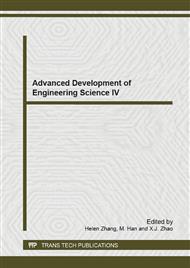p.18
p.22
p.26
p.30
p.34
p.39
p.43
p.50
p.54
2-Naphthalenesulfonic Acid Adsorption on Composite Weakly Basic Resin
Abstract:
The hydroxyl alumina impregnated weakly basic resin composite (D301Al) successfully prepared through incorporation of hydroxyl alumina into the D301 resin for 2-naphthalenesulfonic acid (2-NSA) removal from aqueous solution. The structure of D301Al was examined using scanning electron microscopy and Fourier transform infrared spectroscopy. The adsorption behaviors of 2-NSA on D301Al were investigated by static adsorption experiments. Effects of pH of solution, temperature and contact time were determined. The results indicated D301Al reached the maximum adsorption capacity to 2-NSA with pH 2.4. Nonlinear regression was used to estimate of Langmuir and Freundlich model parameters. And the Langmuir model can give a satisfactory fit of the experimental equilibrium data. The kinetic studies indicated that the adsorption of D301Al for 2-NSA can establish adsorption equilibrium at 8 h. The pseudo-first-order and pseudo-second-order rate models could characterize the kinetic data of 2-NSA adsorption on D301Al.
Info:
Periodical:
Pages:
34-38
Citation:
Online since:
October 2014
Authors:
Keywords:
Price:
Сopyright:
© 2014 Trans Tech Publications Ltd. All Rights Reserved
Share:
Citation:


